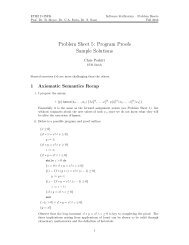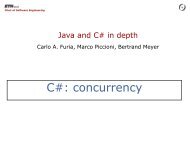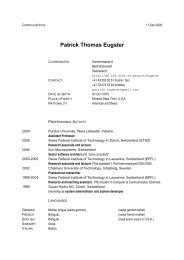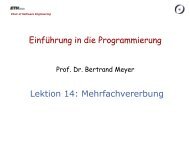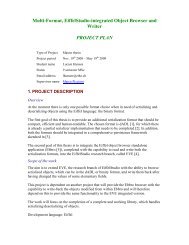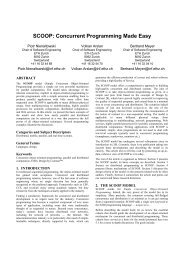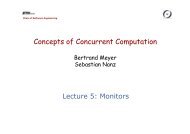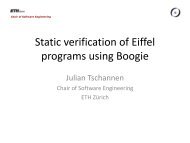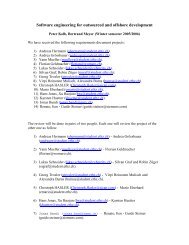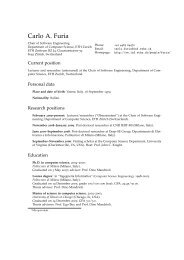Resolving Name-Clashes in Eiffel
Resolving Name-Clashes in Eiffel
Resolving Name-Clashes in Eiffel
Create successful ePaper yourself
Turn your PDF publications into a flip-book with our unique Google optimized e-Paper software.
<strong>Resolv<strong>in</strong>g</strong> <strong>Name</strong>-<strong>Clashes</strong> <strong>in</strong> <strong>Eiffel</strong><br />
Semester Thesis<br />
Alan Fehr<br />
July 15, 2005<br />
Student: Alan Fehr<br />
Student-No: 01-908-862<br />
Supervis<strong>in</strong>g Assistant: Bernd Schoeller<br />
Supervis<strong>in</strong>g Professor: Bertrand Meyer
ETHZ D-INFK <strong>Resolv<strong>in</strong>g</strong> <strong>Name</strong>-<strong>Clashes</strong> <strong>in</strong> <strong>Eiffel</strong><br />
Prof. Dr. Bertrand Meyer Alan Fehr<br />
Contents<br />
1 Def<strong>in</strong>ition of <strong>Name</strong>-<strong>Clashes</strong>.........................................................................................2<br />
1.1 Def<strong>in</strong>ition................................................................................................................................ 2<br />
1.2 <strong>Name</strong>-<strong>Clashes</strong> <strong>in</strong> <strong>Eiffel</strong> ........................................................................................................ 2<br />
1.2.1 Rename for Features ........................................................................................................... 2<br />
1.2.2 LACE .............................................................................................................................. 2<br />
1.2.3 Rename <strong>in</strong> LACE............................................................................................................. 3<br />
1.3 Component Software ........................................................................................................... 4<br />
1.3.1 Def<strong>in</strong>ition............................................................................................................................ 4<br />
2 Possible Solution: <strong>Name</strong>spaces....................................................................................4<br />
2.1 <strong>Name</strong>spaces............................................................................................................................ 4<br />
2.1.1 Modules and <strong>Name</strong>spaces................................................................................................... 4<br />
2.2 Global <strong>Name</strong>spaces .............................................................................................................. 5<br />
2.2.1 Drawbacks of local namespaces........................................................................................... 5<br />
2.2.2 Global <strong>Name</strong>spaces <strong>in</strong> Java................................................................................................ 6<br />
2.3 Drawbacks of <strong>Name</strong>spaces ................................................................................................. 7<br />
2.3.1 Components Revisited ......................................................................................................... 7<br />
3 Possible Solutions for <strong>Eiffel</strong>..........................................................................................7<br />
3.1 Extend<strong>in</strong>g the Language ...................................................................................................... 8<br />
3.1.1 Extensions.......................................................................................................................... 8<br />
3.1.2 An Example.................................................................................................................... 10<br />
3.2 Resolve Wizard: an External Tool ................................................................................... 10<br />
3.2.1 General Use...................................................................................................................... 10<br />
3.2.2 A Detailed View of <strong>Resolv<strong>in</strong>g</strong> Issues ................................................................................ 11<br />
3.2.3 Conflict<strong>in</strong>g Renames.......................................................................................................... 13<br />
4 References ................................................................................................................... 14<br />
1
ETHZ D-INFK <strong>Resolv<strong>in</strong>g</strong> <strong>Name</strong>-<strong>Clashes</strong> <strong>in</strong> <strong>Eiffel</strong><br />
Prof. Dr. Bertrand Meyer Alan Fehr<br />
1 Def<strong>in</strong>ition of <strong>Name</strong>-<strong>Clashes</strong><br />
1.1 Def<strong>in</strong>ition<br />
A name-clash <strong>in</strong> software development is a situation where two constructs use the same name.<br />
For this thesis the construct will be restra<strong>in</strong>ed to the notion of class. Thus, a name clash is a<br />
situation where two classes use the same name.<br />
<strong>Name</strong>-clashes appear ma<strong>in</strong>ly <strong>in</strong> large software projects. When libraries from different sources<br />
are comb<strong>in</strong>ed, the probability that two classes bear the same name <strong>in</strong>creases. Also, <strong>in</strong> projects<br />
with many developers - possibly <strong>in</strong>ternal and external – <strong>in</strong>volved, there is potential for nam<strong>in</strong>g<br />
conflicts to arise.<br />
Many languages provide mechanisms for prevent<strong>in</strong>g name clashes or reduc<strong>in</strong>g their likel<strong>in</strong>ess.<br />
Some of these will be presented <strong>in</strong> the follow<strong>in</strong>g as well as the solutions which <strong>Eiffel</strong> and its<br />
support<strong>in</strong>g tools provide.<br />
1.2 <strong>Name</strong>-<strong>Clashes</strong> <strong>in</strong> <strong>Eiffel</strong><br />
1.2.1 Rename for Features<br />
Due to the fact that <strong>Eiffel</strong> (the programm<strong>in</strong>g language) supports multiple <strong>in</strong>heritance it is<br />
prone to name-clashes at the level of features. However, the language provides a thorough<br />
mechanism for resolv<strong>in</strong>g such name-clashes. The user is required to disambiguate them us<strong>in</strong>g<br />
‘rename’ clauses.<br />
1.2.2 LACE<br />
One of the ideas beh<strong>in</strong>d <strong>Eiffel</strong> is to maximize reusability. For this reason, the language doesn’t<br />
provide a mechanism for assembl<strong>in</strong>g a system. Some external mechanism is therefore needed<br />
to specify the entry-po<strong>in</strong>t for a program. One of these mechanisms is a language called LACE<br />
(Language for Assembl<strong>in</strong>g Classes <strong>in</strong> <strong>Eiffel</strong>).<br />
S<strong>in</strong>ce the <strong>Eiffel</strong> knows noth<strong>in</strong>g of assembl<strong>in</strong>g classes <strong>in</strong>to systems it doesn’t provide a<br />
mechanism for resolv<strong>in</strong>g name-clashes.<br />
2
ETHZ D-INFK <strong>Resolv<strong>in</strong>g</strong> <strong>Name</strong>-<strong>Clashes</strong> <strong>in</strong> <strong>Eiffel</strong><br />
Prof. Dr. Bertrand Meyer Alan Fehr<br />
1.2.3 Rename <strong>in</strong> LACE<br />
LACE offers a rename clause similar to that of the <strong>Eiffel</strong> language. However, this mechanism<br />
is used at the class level rather than the feature level. Us<strong>in</strong>g a rename clause, the user can<br />
disambiguate nam<strong>in</strong>g conflicts manually. The follow<strong>in</strong>g example illustrates the use of rename<br />
<strong>in</strong> ace files. The system conta<strong>in</strong>s two clusters which both conta<strong>in</strong> a class BOX. Assum<strong>in</strong>g the<br />
root cluster is a client of BOX (i.e. it conta<strong>in</strong>s a class referenc<strong>in</strong>g BOX) the compiler doesn’t<br />
know which version of BOX to reference. Us<strong>in</strong>g the rename clause, the user can specify<br />
alternative names for the conflict<strong>in</strong>g classes. It is thus possible for client code to refer to a class<br />
us<strong>in</strong>g a different name than the orig<strong>in</strong>al author had devised.<br />
…<br />
cluster<br />
…<br />
<strong>in</strong>ventory: ".\<strong>in</strong>ventory"<br />
gui: ".\gui"<br />
root_cluster: "."<br />
adapt<br />
<strong>in</strong>ventory: rename BOX as INVENTORY_BOX;<br />
end<br />
gui: rename BOX as GUI_BOX;<br />
The <strong>in</strong>convenience of this solution is that the user must manually resolve name-clashes after<br />
they happen. A convenient mechanism should prevent name-clashes a priori or at least assist<br />
the user <strong>in</strong> disambiguat<strong>in</strong>g them.<br />
3
ETHZ D-INFK <strong>Resolv<strong>in</strong>g</strong> <strong>Name</strong>-<strong>Clashes</strong> <strong>in</strong> <strong>Eiffel</strong><br />
Prof. Dr. Bertrand Meyer Alan Fehr<br />
1.3 Component Software<br />
The trend <strong>in</strong> software development is towards component-oriented systems [3], [4]. They are a<br />
highly desirable form of software development and therefore their implications on namespaces<br />
and vice-versa must be analyzed as well.<br />
1.3.1 Def<strong>in</strong>ition<br />
“A software component is a unit of composition with contractually specified <strong>in</strong>terfaces and explicit context<br />
dependencies only. A software component can be deployed <strong>in</strong>dependently and is subject to composition by third<br />
parties.” – Szyperski and Pfister [3]<br />
The question arises if classes can be viewed as components. Meyer states <strong>in</strong> [1]: “As a<br />
decomposition unit, a class is a module, that is to say a group of related services packaged<br />
together under a s<strong>in</strong>gle name.” Classes and components share many characteristics a<br />
component may however rely on multiple classes. In such a case, a class would no longer be a<br />
unit of <strong>in</strong>dependent deployment s<strong>in</strong>ce it would rely on other classes to provide its specified<br />
services.<br />
How are components accessed? When compos<strong>in</strong>g components, the <strong>in</strong>terface is the essential<br />
part for its reuse. A component will export its functionality (possibly classes) under certa<strong>in</strong><br />
names which may lead to name-clashes. It is not essential that a component have a name, if it<br />
does however, a component becomes very similar to the concept of a module as will be seen<br />
shortly.<br />
2 Possible Solution: <strong>Name</strong>spaces<br />
2.1 <strong>Name</strong>spaces<br />
2.1.1 Modules and <strong>Name</strong>spaces<br />
Many programm<strong>in</strong>g languages solve name-clashes with some form of namespaces. One of the<br />
first languages (if not the first) to <strong>in</strong>troduce such a concept was Modula-2 with modules [5]. A<br />
Module provides a list of services under a common name. They provide more than just a<br />
namespace facility, but it is this facility which helps resolve name clashes. Client code may<br />
disambiguate an imported name by us<strong>in</strong>g the ‘qualified name’, mean<strong>in</strong>g the name preceded by<br />
the module name and a dot (‘.’). The user must specify which modules he wishes to import <strong>in</strong><br />
the same place he uses them.<br />
4
ETHZ D-INFK <strong>Resolv<strong>in</strong>g</strong> <strong>Name</strong>-<strong>Clashes</strong> <strong>in</strong> <strong>Eiffel</strong><br />
Prof. Dr. Bertrand Meyer Alan Fehr<br />
The user isn’t required to use the qualified name a priori however which means a name-clash<br />
can still occur forc<strong>in</strong>g the user to disambiguate it a posteriori. This slight <strong>in</strong>convenience is the<br />
price for the rather large convenience of allow<strong>in</strong>g the user to use shorter names <strong>in</strong> his code (i.e.<br />
unqualified names). This situation occurs <strong>in</strong> most languages which provide some form of<br />
namespaces and cannot be avoided without the pa<strong>in</strong>stak<strong>in</strong>g cost of always us<strong>in</strong>g fully qualified<br />
names. However, the <strong>in</strong>structions on which namespaces or modules to import are commonly<br />
<strong>in</strong> the same place they are used: <strong>in</strong> the source code. The user has a close view over which<br />
namespaces he is currently us<strong>in</strong>g. A good development environment may warn the user of<br />
nam<strong>in</strong>g conflicts due to multiple imports and require that he disambiguates them while<br />
develop<strong>in</strong>g.<br />
2.2 Global <strong>Name</strong>spaces<br />
2.2.1 Drawbacks of local namespaces<br />
<strong>Name</strong>spaces as described <strong>in</strong> the previous section aren’t fully adequate for prevent<strong>in</strong>g nameclashes.<br />
There is no restriction on the names chosen for the namespaces which may lead to a<br />
situation where two namespaces have the same name. Due to the lack of coord<strong>in</strong>ation<br />
between different namespaces, the namespaces as previously described shall be called local<br />
namespaces. Local namespaces just redirect the nam<strong>in</strong>g problem to the namespace level.<br />
Instead of name-clashes at the class level (<strong>in</strong> object-oriented programm<strong>in</strong>g languages) nameclashes<br />
can now occur at the namespace level. Although name-clashes at the namespace level<br />
occur less often (presumably), ambiguous namespace-names don’t provide a def<strong>in</strong>itive<br />
solution.<br />
The motivation beh<strong>in</strong>d global namespaces is to prevent name-clashes at the namespace level.<br />
Two authors could devise the same name for their namespaces. If a client needs to use two<br />
conflict<strong>in</strong>g namespaces he is left without a utility to disambiguate the name-clash. The only<br />
solution would be to manually replace the names of one of the suppliers. This may or may not<br />
be possible, depend<strong>in</strong>g on the form of distribution, and is surely a completely undesirable<br />
solution. The process of renam<strong>in</strong>g would have to be repeated every time the supplier provides<br />
a new version of his software.<br />
5
ETHZ D-INFK <strong>Resolv<strong>in</strong>g</strong> <strong>Name</strong>-<strong>Clashes</strong> <strong>in</strong> <strong>Eiffel</strong><br />
Prof. Dr. Bertrand Meyer Alan Fehr<br />
Both XML [6] and Java [7] provide a mechanism for globally unique namespaces. The XML<br />
Standard suggests us<strong>in</strong>g an URI but acknowledges that URLs can be managed <strong>in</strong> a way to<br />
provide unique namespaces. The Java solution relies on URLs as well and will be described <strong>in</strong><br />
detail.<br />
2.2.2 Global <strong>Name</strong>spaces <strong>in</strong> Java<br />
In Java a package is a named collection of classes (and possibly sub-packages) def<strong>in</strong><strong>in</strong>g a<br />
namespace for the conta<strong>in</strong>ed classes. Similar to the solution <strong>in</strong> Modula-2, developers may<br />
import packages <strong>in</strong> order to use the unqualified names for the conta<strong>in</strong>ed classes as seen <strong>in</strong> the<br />
follow<strong>in</strong>g example.<br />
import java.util.Hashtable;<br />
import java.util.Vector;<br />
…<br />
Hashtable m_states; // can now use unqualified names<br />
Vector m_nfa_states<br />
When declar<strong>in</strong>g a class, the developer may specify which package it belongs to by us<strong>in</strong>g the<br />
package keyword. Sun recommends preced<strong>in</strong>g the package names by the <strong>in</strong>ternet doma<strong>in</strong> of<br />
the author (with reversed elements) as illustrated <strong>in</strong> the follow<strong>in</strong>g.<br />
Package ch.alanfehr.Sort<strong>in</strong>g; //assum<strong>in</strong>g this is my doma<strong>in</strong><br />
class QuickSort {<br />
…<br />
If everybody follows this rule and only uses doma<strong>in</strong>s they own, we are guaranteed globally<br />
unique namespaces. Java furthermore provides access modifiers to specify if classes (and parts<br />
of them) may be accessed from outside of packages. If classes can not be accessed from<br />
outside a package they can also not be seen and will not take up a name for the user of the<br />
package.<br />
6
ETHZ D-INFK <strong>Resolv<strong>in</strong>g</strong> <strong>Name</strong>-<strong>Clashes</strong> <strong>in</strong> <strong>Eiffel</strong><br />
Prof. Dr. Bertrand Meyer Alan Fehr<br />
2.3 Drawbacks of <strong>Name</strong>spaces<br />
Globally unique namespaces provide a solid solution to name-clashes. Unfortunately,<br />
namespaces also <strong>in</strong>troduce new problems. If <strong>in</strong>troduced manually, i.e. neither as part of the<br />
language nor as part of the support<strong>in</strong>g tools, they will result <strong>in</strong> clumsy and hard-to-manage<br />
code. If merely <strong>in</strong>cluded <strong>in</strong> the support<strong>in</strong>g tools the use of namespaces <strong>in</strong> code will be<br />
<strong>in</strong>convenient. Thus, the language must be extended by a new construct serv<strong>in</strong>g the sole<br />
purpose of disambiguat<strong>in</strong>g names. Includ<strong>in</strong>g such ‘artificial’ constructs can be undesirable <strong>in</strong> a<br />
language striv<strong>in</strong>g for simplicity and self-conta<strong>in</strong>ment.<br />
In systems with hierarchical namespaces refactor<strong>in</strong>g can also be a problem. An example would<br />
be mov<strong>in</strong>g a Java subpackage <strong>in</strong> the hierarchy. Any client code us<strong>in</strong>g that class would be<br />
broken. This situation can also occur <strong>in</strong> systems with flat (i.e. non-nested) namespaces, but<br />
chang<strong>in</strong>g the hierarchy of systems is a common refactor<strong>in</strong>g task, whereas completely remov<strong>in</strong>g<br />
a class from a group and <strong>in</strong>sert<strong>in</strong>g it <strong>in</strong>to another def<strong>in</strong>itely should not be.<br />
2.3.1 Components Revisited<br />
This view is confirmed if we consider namespaces as components. Given two <strong>in</strong>dividually<br />
distributable components classes should never be moved from one to the other while<br />
refactor<strong>in</strong>g. Do<strong>in</strong>g so would break any clients rely<strong>in</strong>g on the component los<strong>in</strong>g the class which<br />
don’t use the receiv<strong>in</strong>g component.<br />
The desirable situation would be for components to be non-hierarchical namespaces. Any<br />
namespaces depended on should be <strong>in</strong>cluded, but hidden from clients. This may of course lead<br />
to multiple <strong>in</strong>clusions of a namespace, but this shouldn’t pose a problem. A smart compiler<br />
will only <strong>in</strong>clude one <strong>in</strong>stance of the identical code.<br />
3 Possible Solutions for <strong>Eiffel</strong><br />
Two solutions for resolv<strong>in</strong>g name-clashes <strong>in</strong> <strong>Eiffel</strong> will be shown <strong>in</strong> this chapter. The first<br />
solution suggests extend<strong>in</strong>g the language to prevent name-clashes a priori while the second<br />
solution provides a tool for resolv<strong>in</strong>g name-clashes a posteriori.<br />
7
ETHZ D-INFK <strong>Resolv<strong>in</strong>g</strong> <strong>Name</strong>-<strong>Clashes</strong> <strong>in</strong> <strong>Eiffel</strong><br />
Prof. Dr. Bertrand Meyer Alan Fehr<br />
3.1 Extend<strong>in</strong>g the Language<br />
3.1.1 Extensions<br />
As shown, hierarchical namespaces are undesirable because they impose problems on<br />
refactor<strong>in</strong>g. It is also desirable to impose a nam<strong>in</strong>g mechanism which will guarantee globally<br />
unique names. A reasonable solution would therefore <strong>in</strong>clude flat namespaces with the nam<strong>in</strong>g<br />
scheme used <strong>in</strong> Java.<br />
<strong>Eiffel</strong> lacks the possibility to restrict access to a class <strong>in</strong> its entirety (although LACE provides<br />
such a mechanism). It only provides access restriction at the feature level. A mechanism for<br />
completely hid<strong>in</strong>g classes is also a desirable feature; hidden classes would not take up names<br />
and clients of a component wouldn’t know about a hidden class at all.<br />
Apart from specify<strong>in</strong>g access restrictions when def<strong>in</strong><strong>in</strong>g classes it should also be possible to<br />
specify which imported classes should be re-exported. Such an export would be necessary if an<br />
exported class has a feature which <strong>in</strong>cludes the imported class <strong>in</strong> the signature.<br />
Feature Implementaion<br />
Global <strong>Name</strong>spaces<br />
Class Access Restriction<br />
Add a keyword namespace and require a namespace clause at<br />
the beg<strong>in</strong>n<strong>in</strong>g of a class file. A namespace clause is composed<br />
of the keyword and an identifier, specify<strong>in</strong>g which package<br />
the class is <strong>in</strong>:<br />
namespace doma<strong>in</strong>.package_name<br />
Use the same mechanism which is used for restriction at the<br />
feature level: a class may optionally specify who may access it<br />
(and thus to whom it is visible).<br />
class MYCLASS {accessors}<br />
8
ETHZ D-INFK <strong>Resolv<strong>in</strong>g</strong> <strong>Name</strong>-<strong>Clashes</strong> <strong>in</strong> <strong>Eiffel</strong><br />
Prof. Dr. Bertrand Meyer Alan Fehr<br />
<strong>Name</strong>space Access<br />
Restriction<br />
Import<strong>in</strong>g <strong>Name</strong>spaces<br />
Re-export<strong>in</strong>g classes<br />
Allow namespace names <strong>in</strong> access lists. Add<strong>in</strong>g the keyword<br />
namespace to an access list denotes the current namespace,<br />
the follow<strong>in</strong>g class is only visible from with<strong>in</strong> the current<br />
namespace.<br />
class MYCLASS {namespace}<br />
Add a keyword us<strong>in</strong>g and an import clause specify<strong>in</strong>g which<br />
namespaces to import. The clause must appear after the<br />
namespace clause but before the class declaration.<br />
us<strong>in</strong>g ns1, ns2, ns3<br />
Any imported classes appear<strong>in</strong>g <strong>in</strong> exported feature signatures<br />
are exported with the same status as the feature. Optionally, it<br />
could be allowed to specify classes us<strong>in</strong>g the export keyword<br />
<strong>in</strong> a us<strong>in</strong>g clause. The exported classes would be enclosed by<br />
export and end. The keyword all would export all classes<br />
<strong>in</strong> the namespace.<br />
us<strong>in</strong>g parser export all end,<br />
structure export TABLE end<br />
9
ETHZ D-INFK <strong>Resolv<strong>in</strong>g</strong> <strong>Name</strong>-<strong>Clashes</strong> <strong>in</strong> <strong>Eiffel</strong><br />
Prof. Dr. Bertrand Meyer Alan Fehr<br />
3.1.2 An Example<br />
-- file: application.e<br />
namespace ch.alanfehr.resolve_wizard<br />
us<strong>in</strong>g com.gobosoft.et_tools -- conta<strong>in</strong>s class LACE_PARSER<br />
class APPLICATION {ALL} -- do not restrict access<br />
create<br />
…<br />
feature<br />
…<br />
parse_with_lace_parser(parser: LACE_PARSER, file: STRING) is<br />
-- LACE_PARSER is now also exported<br />
do<br />
…<br />
end<br />
-- file constants.e<br />
namespace ch.alanfehr.resolve_wizard<br />
class CONSTANTS {namespace} -- restrict access to current namespace<br />
…<br />
3.2 Resolve Wizard: an External Tool<br />
<strong>Resolv<strong>in</strong>g</strong> <strong>Eiffel</strong> name-clashes a posteriori us<strong>in</strong>g LACE and manual renam<strong>in</strong>g can be<br />
cumbersome. Resolve Wizard is a tool which assists the user <strong>in</strong> resolv<strong>in</strong>g name-clashes <strong>in</strong> an<br />
<strong>Eiffel</strong> / LACE project.<br />
3.2.1 General Use<br />
The tool provides a GUI which allows the user to load the ace file of his project. The tool then<br />
loads the entire project – which must all be provided as source code - and checks for nameclashes.<br />
It displays <strong>in</strong>formation about conflict<strong>in</strong>g names and checks if any conflicts need<br />
10
ETHZ D-INFK <strong>Resolv<strong>in</strong>g</strong> <strong>Name</strong>-<strong>Clashes</strong> <strong>in</strong> <strong>Eiffel</strong><br />
Prof. Dr. Bertrand Meyer Alan Fehr<br />
resolv<strong>in</strong>g. A nam<strong>in</strong>g conflict is found if two or more files (<strong>in</strong> different clusters) declare a class<br />
with the same name. A conflict may also arise, when an adapt clause (<strong>in</strong> the ace file) renames a<br />
class to an already exist<strong>in</strong>g class name. Conflicts only need to be resolved if there is a client of<br />
the conflict<strong>in</strong>g class <strong>in</strong> a different cluster. Clients <strong>in</strong> the same cluster refer to the sibl<strong>in</strong>g class<br />
per default. The case where a user def<strong>in</strong>es a conflict<strong>in</strong>g class and a client, which should refer to<br />
an external provider, <strong>in</strong> the same cluster is not handled by this tool.<br />
If there are conflicts <strong>in</strong> need of resolv<strong>in</strong>g, the tool displays options for each resolve issue. A<br />
resolve issue consists of a name-clash and all clients resid<strong>in</strong>g <strong>in</strong> a specific cluster. Clients <strong>in</strong> a<br />
different cluster form a separate resolve issue s<strong>in</strong>ce LACE adapt clauses only apply to one<br />
cluster. The options for an issue <strong>in</strong>clude renam<strong>in</strong>g a class (by us<strong>in</strong>g a rename clause <strong>in</strong> the ace<br />
file, the class itself is not changed) and the references <strong>in</strong> its clients, ignor<strong>in</strong>g a cluster and<br />
remov<strong>in</strong>g a conflict<strong>in</strong>g rename clause.<br />
3.2.2 A Detailed View of <strong>Resolv<strong>in</strong>g</strong> Issues<br />
11
ETHZ D-INFK <strong>Resolv<strong>in</strong>g</strong> <strong>Name</strong>-<strong>Clashes</strong> <strong>in</strong> <strong>Eiffel</strong><br />
Prof. Dr. Bertrand Meyer Alan Fehr<br />
This w<strong>in</strong>dow displays options for resolv<strong>in</strong>g an issue. The “Clients” display shows the client<br />
cluster and all its classes which have references to the conflict class. The “Class” display<br />
specifies which class is the root of the conflict.<br />
All clusters which def<strong>in</strong>e the conflict<strong>in</strong>g class are listed under “Clusters”. To resolve a conflict<br />
the user must select a cluster from the list and press either Ignore or Rename. Ignore is to be<br />
used with care and should only be selected if no listed clients have references to any classes <strong>in</strong><br />
the selected cluster. The cluster will be completely ignored and s<strong>in</strong>ce the tool does not check<br />
for further references to the cluster, ignor<strong>in</strong>g a needed cluster leads to an <strong>in</strong>valid system. The<br />
safer alternative is to use Rename.<br />
The tool will add a rename clause to the ace file, renam<strong>in</strong>g<br />
the class (PARSER) to the specified name<br />
(EIFFEL_PARSER). It will also rename the references <strong>in</strong><br />
all selected files.<br />
The “Next” button will become available if the issue is resolved. An issue is resolved <strong>in</strong> both<br />
of the follow<strong>in</strong>g cases:<br />
• all clients have been renamed<br />
• the field “Clusters” lists less than two clusters<br />
If “Next” is pressed, all class files which were selected for rename are processed and the<br />
references there<strong>in</strong> are renamed. The tool creates backup files with an additional “.bak”<br />
extension. If there are further issues to be resolved, the tool proceeds to the next issue. If the<br />
current issue was the last, the tool makes the selected changes to the ace file, also creat<strong>in</strong>g a<br />
backup file, and returns to the ma<strong>in</strong> w<strong>in</strong>dow.<br />
12
ETHZ D-INFK <strong>Resolv<strong>in</strong>g</strong> <strong>Name</strong>-<strong>Clashes</strong> <strong>in</strong> <strong>Eiffel</strong><br />
Prof. Dr. Bertrand Meyer Alan Fehr<br />
If “Cancel” is pressed, the tool returns to the ma<strong>in</strong> w<strong>in</strong>dow, without modify<strong>in</strong>g the ace file.<br />
Changes made to class files <strong>in</strong> previous steps are not removed, however.<br />
3.2.3 Conflict<strong>in</strong>g Renames<br />
Rename clauses can also lead to name-clashes though it is an uncommon scenario. The tool<br />
only supports remov<strong>in</strong>g the rename clause, no references are renamed. This may lead to<br />
references po<strong>in</strong>t<strong>in</strong>g to the wrong class. Also, remov<strong>in</strong>g the rename-clause may lead to a new<br />
name-clash which will go unnoticed and unhandled <strong>in</strong> the current session. The recommended<br />
solution is to keep the rename clause and use Rename or Ignore on the other clusters.<br />
13
ETHZ D-INFK <strong>Resolv<strong>in</strong>g</strong> <strong>Name</strong>-<strong>Clashes</strong> <strong>in</strong> <strong>Eiffel</strong><br />
Prof. Dr. Bertrand Meyer Alan Fehr<br />
4 References<br />
[1] Bertrand Meyer: <strong>Eiffel</strong> –The Language, Prentice Hall 1992<br />
[2] Bertrand Meyer: Object-Oriented Software Construction, 2nd edition, Prentice Hall,<br />
1997.<br />
[3] Clemens Szyperski: Component Software – Beyond Object-Oriented Programm<strong>in</strong>g,<br />
2 nd edition, Addison-Wesley / ACM Press, 2002<br />
[4] Kar<strong>in</strong>e Arnout: From Patterns to Components, ETH-HDB (Zurich) 2004<br />
[5] Niklaus Wirth: Programmieren <strong>in</strong> Molula-2, 2 nd edition, Spr<strong>in</strong>ger 1991<br />
[6] W3C: <strong>Name</strong>spaces <strong>in</strong> XML, http://www.w3.org/TR/REC-xml-names/, 1999<br />
[7] David Flanagan, Java <strong>in</strong> a Nutshell, 3 rd edition, O’Reilly 1999<br />
14



